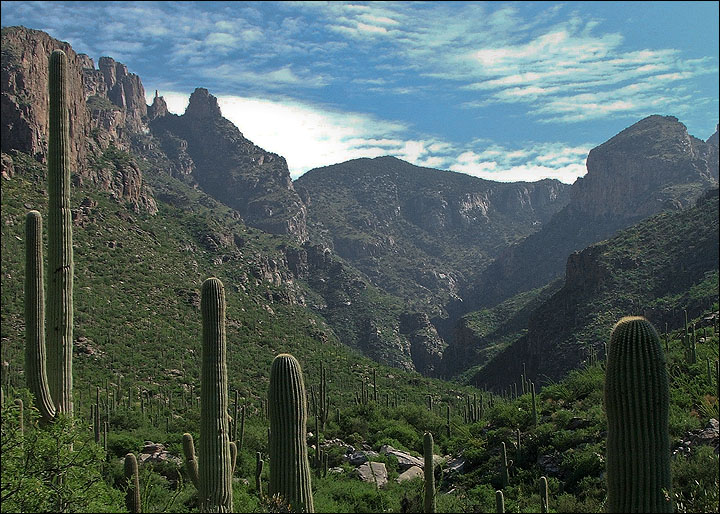
On the Trail
Dave Bertelsen carefully placed his foot on a slab of water-polished rock made slick by overnight monsoon rains. Hiking to a perch that overlooks Finger Rock Canyon arroyo, now rushing with coffee-colored water, he pointed to three seemingly ordinary clumps of grass. To Bertelsen, the plants are weeping muhly, a rare species known to grow in only five locations in Arizona. Bertelsen discovered these on one of his 1,268 round-trip hikes along the Finger Rock Trail, a path that scrambles five miles up into the Santa Catalina Mountains north of Tucson, Arizona.

The view north from Tucson, Arizona into Finger Rock Canyon. Saguaro cacti stand out in the foreground; on the horizon, slender Finger Rock points to the sky. Photo courtesy of Zack Guido.
Bertelsen is a self-trained naturalist with perhaps the most in-depth knowledge in the world of plants in the Catalina Mountains, one of Arizona’s “sky islands” that tower above surrounding deserts. Within a distance of 30 feet from the Finger Rock Trail, he can readily identify 600 different kinds of plants. Since 1981, Bertelsen has been hiking the rugged trail on a regular basis, logging more than 12,650 miles. On each trip, he pays attention to the comings and goings of plants and animals, meticulously recording which plant species are in bloom.
He started recording blooming dates not as a PhD student or as a paid biologist, but “out of curiosity,” he said.
To scientists at The University of Arizona and at the National Phenology Network in Tucson, Bertelsen’s efforts are vital to documenting changes in the timing of life cycle events, such as first flowering date, and to observing landscape changes stemming from climate change. But to Bertelsen, the pursuit of science is trumped by his affection for the desert and Finger Rock Canyon.
“I love the canyon. The diversity of flowers is astounding,” Bertelsen said. “Each hike is exciting. Each time I see something new. Though the canyon accounts for only 1 percent of the area of the Catalina Mountains, it hosts more than 40 percent of the plant diversity found in the entire mountain range.”
Bertelsen crouched on the exposed bedrock with his back to the weeping muhley grass and pointed to seedlings sprouting nearby. Although he’s hesitant to identify them before they flower, Bertelsen recognizes them as smallflower halfchaff sedge. “I’ve only seen this plant at this one location on the mountain,” he said.
He then proceeded to recount a story of John Lemmon and Cyrus Pringle, prolific collectors of flora across the Southwest in the late 1800s. The pair were the first to collect a plant called netted anoda in 1881. This rare flowering plant was again collected in 1939 and 1940 west of Nogales, but it hadn’t been seen in Arizona since then, until Bertelsen discovered it on this trail in 2007.
Bertelsen continues with the history lesson but stops midsentence. “Oh, wow!” he said. “I haven’t seen that since 2002.” He squinted, visually prying apart a canopy of desert scrub and pointed to a hint of yellow. “That’s Hooker’s evening primrose. It’s a night bloomer that is pollinated by sphinx moths.”
It’s amazing that the scientific value of Bertelsen’s knowledge was only recently recognized. In fact, most botanists aware of his work have shown little interest in his efforts, and some have told him he was wasting his time. One called him “the last of the 19th century botanists,” a reference to people who collected plants solely for their own amusement. Bertelsen, however, did have a purpose. His plan from the get-go included dividing the trail into five segments so that he could track the flowering of plant species at different elevations.
Mike Crimmins, a climate science extension specialist for the University of Arizona, immediately saw the value of Bertelsen’s observations. By 2003, Bertelsen had amassed a continuous 20-year record of first blooming dates for hundreds of plants that spanned more than 4,000 feet of elevation. By 2009, though injuries had slowed his data collection for two years, Bertelsen had added another four continuous years of first-blossom dates to his records. In his 24 years of complete records, he cataloged 131,369 observations of plants in flower. He also noted more than 64,000 observations of animals along the trail, including birds, frogs, and snakes.
“I nearly fell out of my chair,” said Crimmins. “Bertelsen unknowingly created the world’s first long-term record of phenology—the study of the timing of life cycle events in plants and animals—that spans a large range of elevation. On top of that, he compiled the record with such a high level of detail that he has produced an incredibly rich dataset. Much remains to be learned from his work,” Crimmins said.



